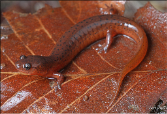Gulf Coast Mud Salamander (Pseudotriton flavissimus)
Description: This species has a salmon to reddish-brown color with small dark spots; the underside is lighter and unmarked. Coloration darkens with age and size, obscuring the spots. It is a small and slender form of the Mud Salamander, reaching a maximum length of 12 cm. This species is often confused with the Red Salamander (Pseudotriton ruber), as these species look similar and co-exist throughout much of their ranges. However, Mud Salamanders generally differ in having fewer spots, a blunter snout, and brown irises. Larval Mud Salamanders tend to have much "bushier" gills than larval Red Salamanders.
Habitat: Throughout its range, this species is true to its name, occupying lowland muddy habitats often associated with spring-fed and oxbow pools, swampy sloughs, and ponds. This species is highly fossorial, occupying tunnel systems in the vicinity of these wetland habitats. Juveniles (larvae) live in slow-moving springs, seepages, or floodplain ponds. Rarely encountered above ground.
Range: This former subspecies of P. montanus is found in easternmost Louisiana, Mississippi, Alabama, Georgia, and western Florida.
Diet: The diet of these salamanders is largely unknown. Larvae eat aquatic invertebrates and other salamander larvae, while adults may eat smaller salamanders.
Reproduction: The ecology of this species is poorly understood in Alabama. Throughout their range, Mud Salamander females probably lay eggs in underground sites near springs and seeps in the late fall/early winter. Few nests have been found. Eastern Mud Salamander (Pseudotriton montanus montanus) clutches range from 77 to 192 eggs; larger females lay more eggs. The eggs hatch in winter.
After hatching, individuals have an aquatic larval period of 15 - 19 months. Larvae live within the leaf-litter of their aquatic habitats, breathing through gills. Often these pools will dry up during warm summer months; larvae presumably recede to underground cavities when this occurs. Upon reaching a suitable size (7 – 9 cm total length), larvae stop feeding, absorb their gills, and metamorphose to the adult form. Mud Salamander larvae grow more quickly than Red Salamander larvae.
Status: Listed as Least Concern in view of its wide distribution and presumed large and stable population.
Taxonomy: On February 6, 2024 Pseudotriton montanus floridanus was replaced with Pseudotriton floridanus and the Gulf Coast Muyd Salamander was elevated to Species Status
»» Kingdom: Animalia - Animals
»» Phylum: Chordata - Chordates
»» Subphylum: Vertebrata - Vertebrates
»» Class: Amphibia - (Amphibians)
»» Order: Caudata - Salamanders
»» Family: Plethodontidae - Lungless Salamanders
»» Genus: Pseudotriton
»» Species: Pseudotriton flavissimus - Gulf Coast Mud Salamander
This article uses material from the Wikipedia article "Mud salamander", which is released under the Creative Commons Attribution-Share-Alike License 3.0. Content may have been omitted from the original, but no content has been changed or extended.
|








